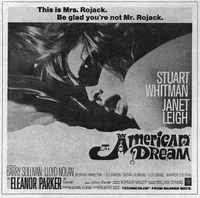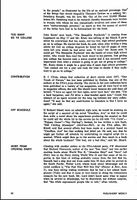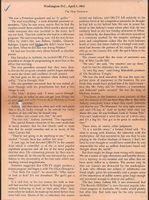An American Dream Expanded: Difference between revisions
m (→Gallery: adding Huffman-Jungian Outline) |
m (→Gallery: adding Huffman-Jungian Outline) |
||
| Line 56: | Line 56: | ||
|File:1650403.JPG|''The New Republic'' April 3, 1965 | |File:1650403.JPG|''The New Republic'' April 3, 1965 | ||
|File:20190302 002 .JPG|John Braine-Coming Up Fiction | |File:20190302 002 .JPG|John Braine-Coming Up Fiction | ||
|File:Huffman - Jungian Approach (1).jpg|An outline for James Huffman's presentation on ''An American Dream'' at the American Culture Association's Popular Culture Conference, April 25-28, 1979. | |||
}} | }} | ||
<div style="clear:both;"></div> | <div style="clear:both;"></div> | ||
Revision as of 17:56, 20 April 2019
| An American Dream | Expanded | Bibliography | Letters | Timeline | Word Count Comparison | Credits |
This project is coming in the spring of 2019. If you’d like to contribute, see the discussion page. |
| “ | An American Dream is Norman Mailer’s first novel in nine years. He wrote it at a high pitch, each chapter appearing in Esquire while he was still at work on the next: a method now unusual but common enough among the great novelists of the nineteenth century, which contributed much to the quivering tension of the story.
The theme of challenge suggested by Mailer’s choice of this method is very much a part of the book. His hero challenges the Devil himself. Stephen Rojack kills his wife, lies to the police, is interrogated by them, discovers a woman, his wife’s opposite, in whom he senses the truth and strength he longs for. The ingredients of his story are deliberately those familiar from many a thriller or movie-murder—suspense, sex—but Rojack lives these experiences with a fierce intensity which shatters their popular image and reveals extraordinary meanings behind them. He is a man who believes in God and the Devil, and to whom God is courage, not love. His actions become explosively significant because he feels that any one of them might open the crack through which the Devil’s power, or that of God, could flood in. Simply on the level of ‘what will happen next?’ An American Dream grips relentlessly: will the suspicious police pounce on Rojack? Will he and Cherry, his new girl, be able to establish the love which has begun to grow between them? But beyond this there is the immense exhilaration springing from the boldness and passion with which Norman Mailer tackles his central theme of man as the battleground for God and the Devil. This is his most exciting book since The Naked and the Dead, which became a modern classic and has sold, over two and a half million copies in the English language. |
” |
| — Dust jacket text, British edition, Andre Deutsch, April 1965. | ||
Gallery
“Major Reviews for a Major Novel” in the NYT.
Best seller list of the week in Publishers Weekly, May 1965, showing An American Dream in No. 6 position.
Announcement of Warner Brothers studios purchasing the movie rights to An American Dream, March 2, 1964
Norman Mailer's An American Dream (Dial Press) is reviewed on the cover of the March 14, 1965 issue of BOOK WEEK by Tom Wolfe
- 19650401.1 Herald Tribune.JPG
Mailer hosts party for Jose Torres,Herald Tribune April 1, 1965 page 2 of 2
Blurbs and Snippets
Letters
Granville Hicks, in his review of Norman Mailer’s An American Dream [SR, March 20], tells us that Mailer’s main character has no reality, the other characters are “dummies,” the writing is sloppy, and the plot is absurd. One might say the same about Dostoevsky’s Notes from the Underground. Perhaps An American Dream is not a great book, but it is most certainly not a “bad joke.” It contains scenes of great power and pages of brilliant imagery. It holds one’s interest. It is an entertaining book to read. ~W. K. MASON, Madison, Wis.
Reviews
William F. Buckley, Jr. states: “it was Mailer who developed the cult of the Hipster—the truly modern American who lets the bleary world go by doing whatever it bloody well likes, because nothing it does can upset the Hipsters’ inexhaustible Cool.” (The Miami Herald, September 26, 1965)






































![Granville Hicks, in his review of Norman Mailer’s An American Dream [SR, March 20], tells us that Mailer’s main character has no reality, the other characters are “dummies,” the writing is sloppy, and the plot is absurd. One might say the same about Dostoevsky’s Notes from the Underground. Perhaps An American Dream is not a great book, but it is most certainly not a “bad joke.” It contains scenes of great power and pages of brilliant imagery. It holds one’s interest. It is an entertaining book to read. ~W. K. MASON, Madison, Wis.](/images/thumb/a/a1/19650417_Letter.jpg/157px-19650417_Letter.jpg)
